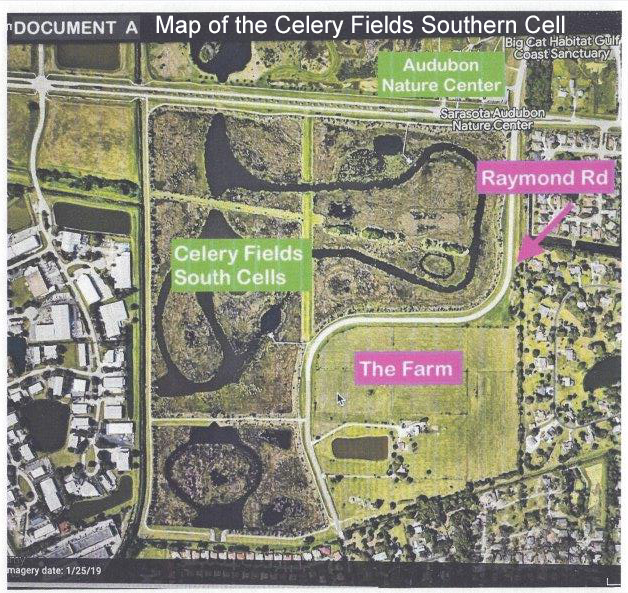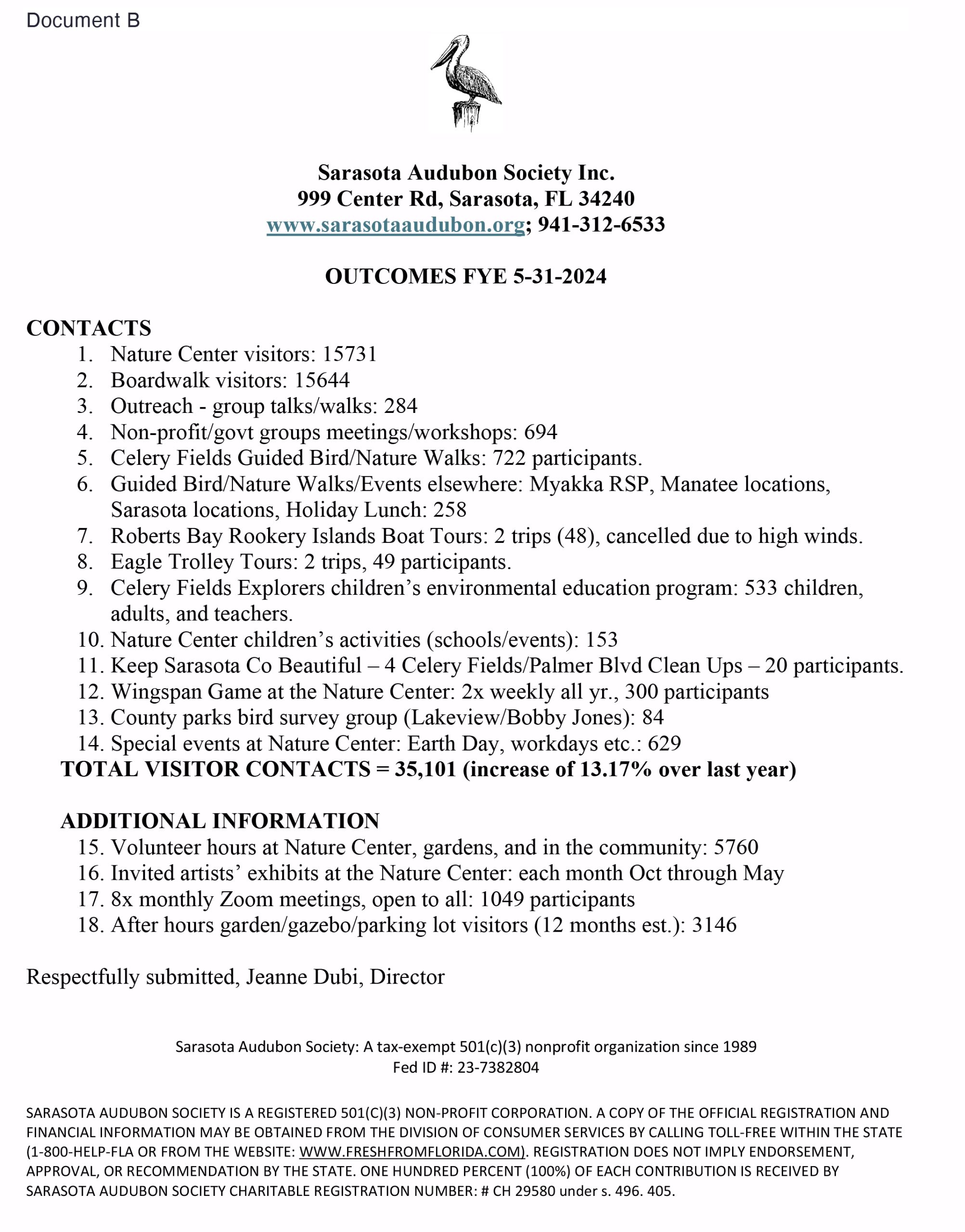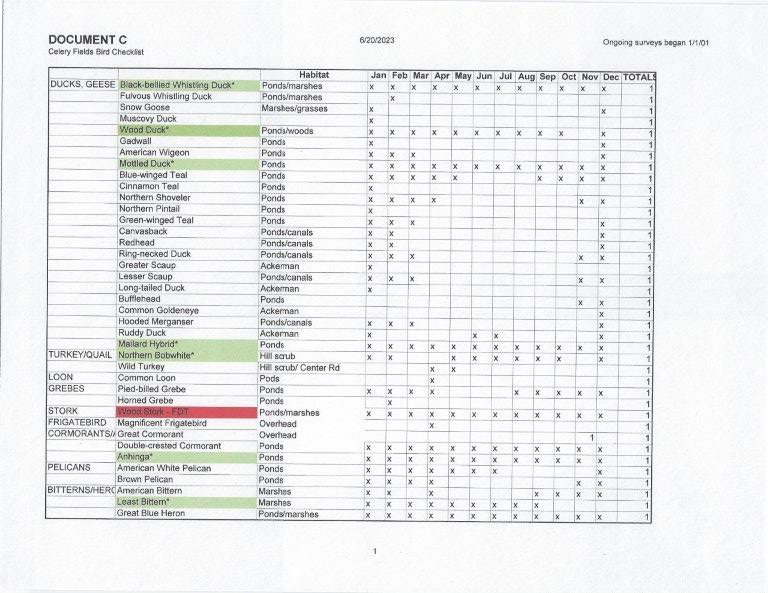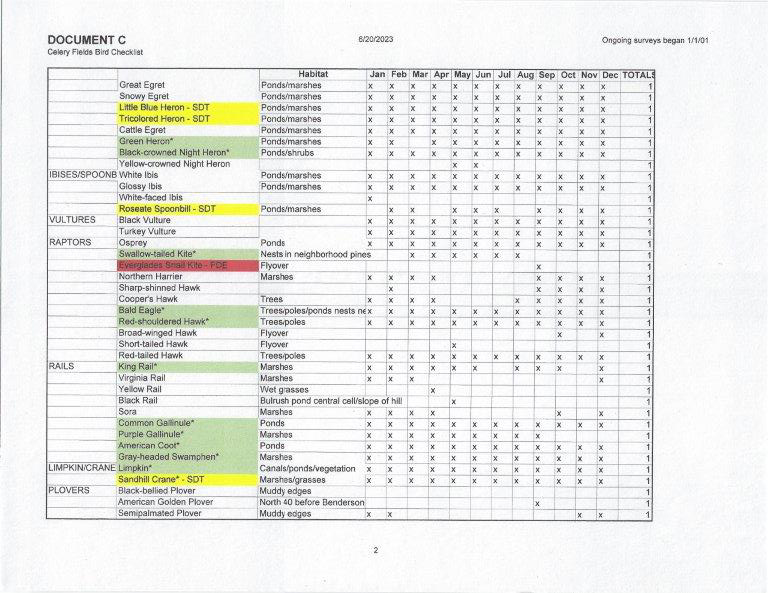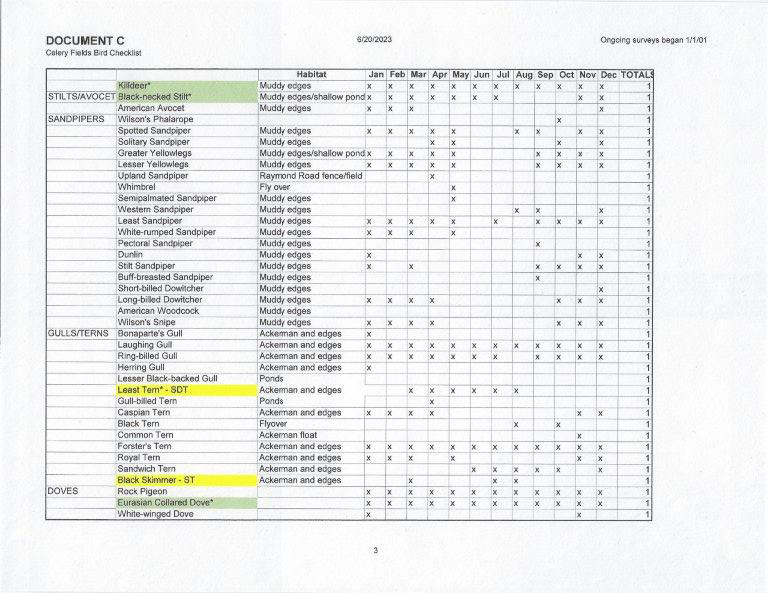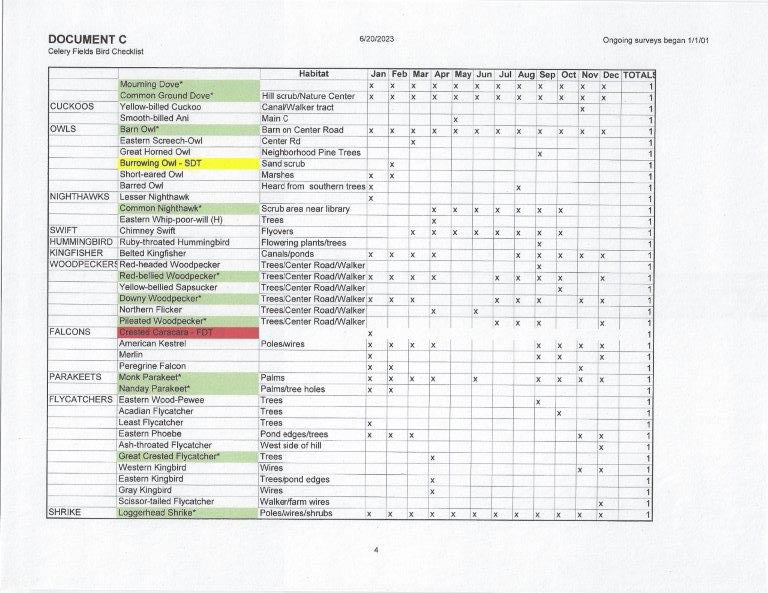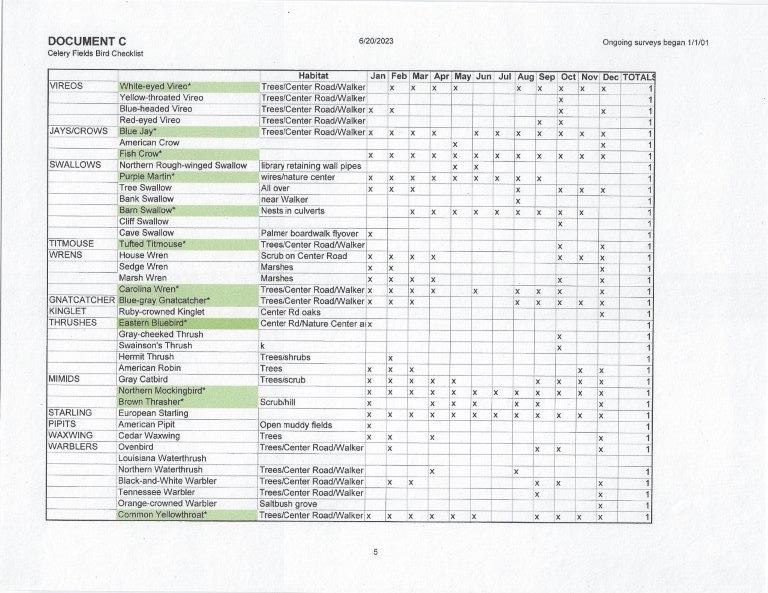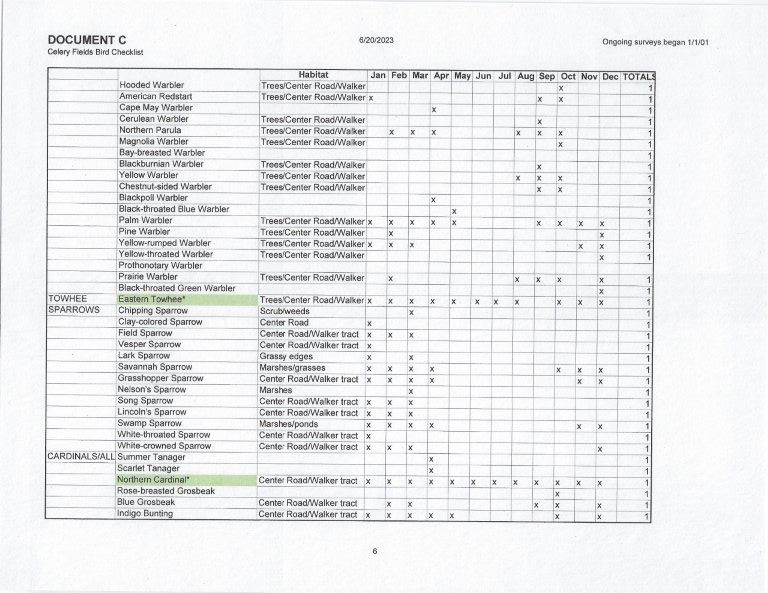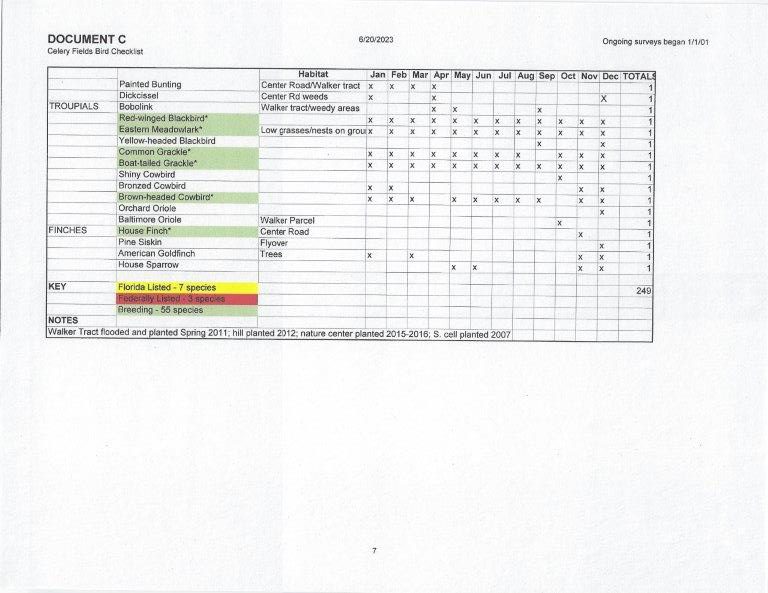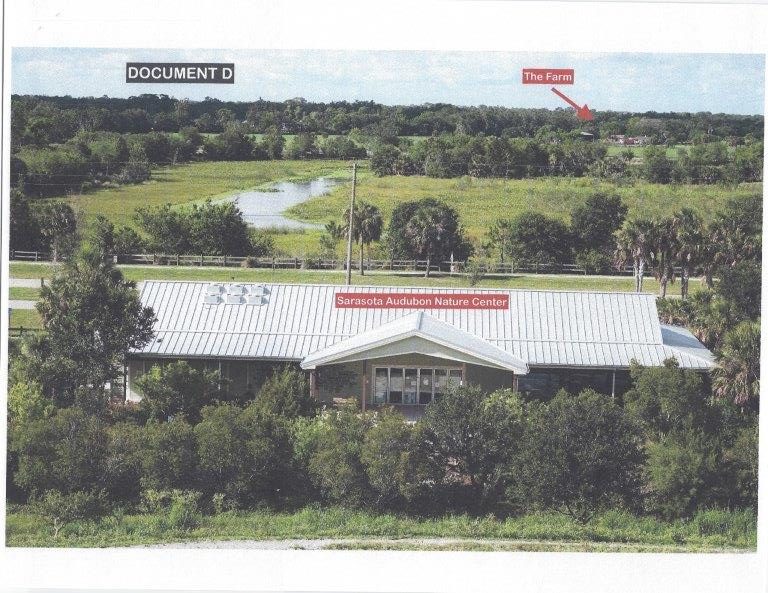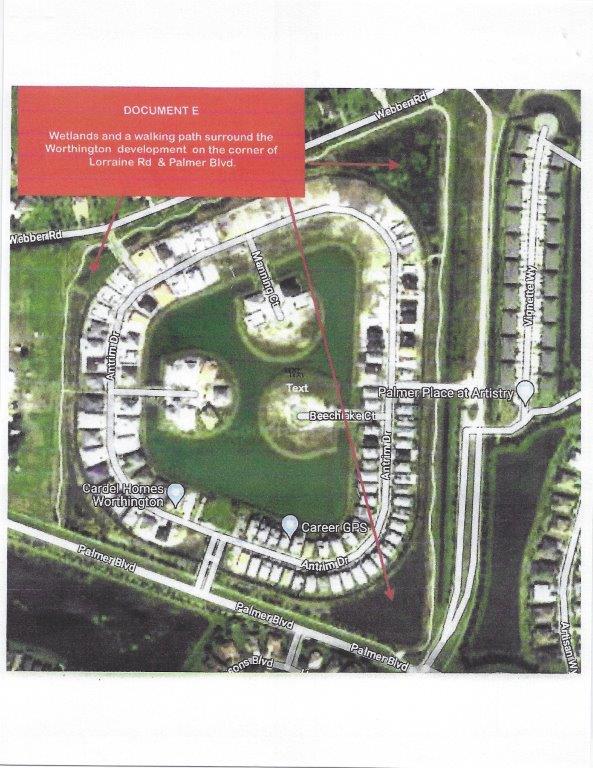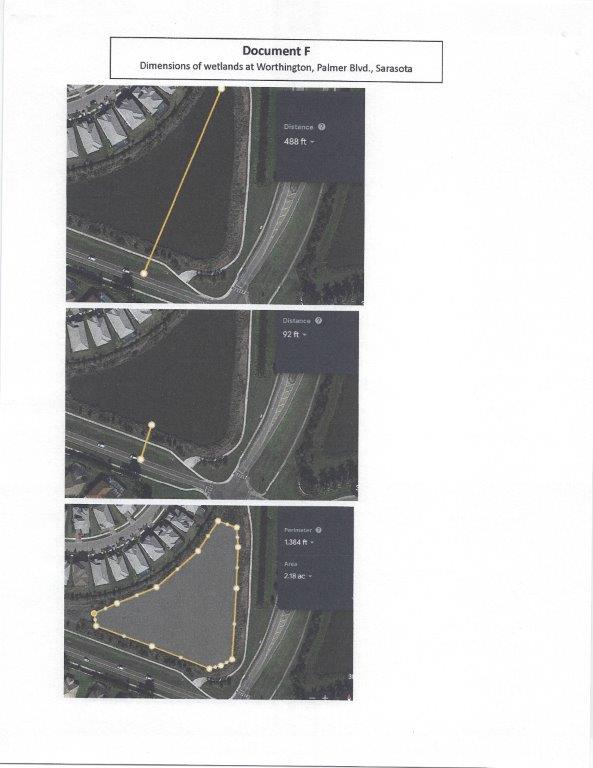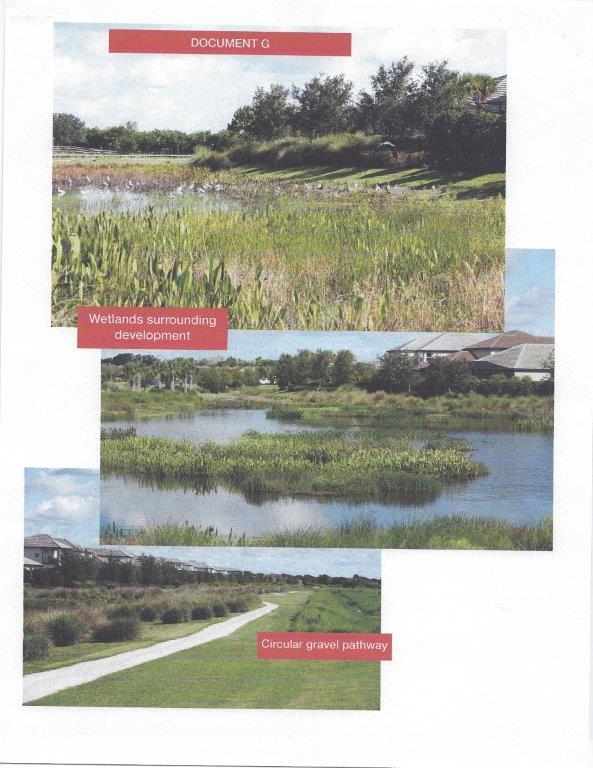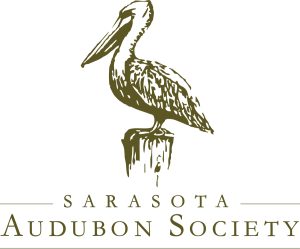
June 7, 2023
Sarasota Audubon Society
999 Center Rd
Sarasota, FL 34240
www.sarasotaaudubon.org
Sarasota Audubon’s Position re: Smith Properties
The Smith farm has always been part of what we appreciate in the Raymond Road portion of the Celery Fields. We can accept and respect that the family may now wish to sell their farm. Our concern is how the farm can be sold responsibly without compromising the enormous strategic importance of its location across the street from the Celery Fields (click to see Document A, map of area in question). We believe the property the Smiths are proposing to sell must be maintained at a low density; rezoning would be a disaster for the Celery Fields. We need this buffer to protect the Celery Fields for the following reasons:
The Celery Fields is a wildlife, birdwatching, and recreational paradise in the heart of Sarasota attracting thousands of local residents and national and international tourists annually.
The Celery Fields is a highly regarded, award-winning feat of creative planning – a triple purpose public facility:
1. a stormwater control and cleansing operation,
2. wetlands protected as a natural haven for local and migrating birds and other wildlife, and
3. a place for people to walk, exercise, kayak, and learn about the wildlife of our area.
The Celery Fields represents Sarasota County’s remarkable achievement in highlighting and preserving the importance of ecosystems, wetlands, native and migrating creatures, and human relationships to all of these treasures.
This crowning achievement in civil engineering and in public/private cooperation must not be jeopardized. All these ecological and practical values, underscored by the millions of dollars invested in realizing them, require any impinging development to be examined with extreme care and attention. Just as a dumpsite or commercial development would be totally inappropriate, a housing subdivision would likely destroy or devalue what has been achieved. There is no way to guarantee that the Celery Fields would not be negatively impacted. Once done, it could be destroyed forever.
There are an estimated 100,000 visitors a year to the Celery Fields–photographers, nature lovers, walkers, joggers, bikers, families, and education groups–providing an enormous boost to the local economy. Since the pandemic, interest in eco-tourism and birding has surged greatly in popularity. Just this season (Oct – May 2023), Audubon has recorded over 31,000 visitors for bird and wildlife viewing, and for its education programs (click to see Document B, Sarasota Audubon Visitor Statistics).
The Celery Fields is recognized as one of the premier birding areas in Florida with over 249 known species of local and migratory birds including three federally imperiled species—Snail Kite, Wood Stork, and Crested Caracara–and seven Florida imperiled species including Roseate Spoonbill, Least Tern, and Burrowing Owl (click to see Document C, Celery Fields Bird List). Amazingly, the diversity of the bird population at the Celery Fields equals that of the much larger Myakka State Park! According to Tripadvisor, “Celery Fields is the best birding place in Sarasota County.”
Adverse effects on bird populations. Birds frequent the Celery Fields to roost, to nest, and many to breed. Studies have shown that traffic, noise, bright night lights, and buildings encroaching on wildlife drives them further into the center of an area, crowding them and setting up competition for resources, invariably leading to a decline in wildlife populations.
Financial investment in the Celery Fields. Sarasota County secured grants of over $5 million from various state and federal agencies to convert 140+ acres of the Celery Fields into a natural wetland – just opposite the Smith Properties. In addition, Sarasota Audubon, recognizing the potential of the Celery Fields as an eco-tourism destination, invested over $1 million in a Nature Center. This award-winning center has received visitors from all 50 states, Puerto Rico, the District of Columbia, and 45 countries (click to see Document D, photo of Sarasota Audubon’s Nature Center with the farm behind).
The critical importance of buffers. Recognizing the need to buffer the Celery Fields from further development, Sarasota Audubon has an agreement with Sarasota County to manage 27 acres of the Quad parcels west of the Celery Fields. Sarasota Audubon, in partnership with the Conservation Foundation of the Gulf Coast, is committed to raising over $4 million for this project. Needless to say, any developer of the Smith parcels must recognize the need for a suitable buffer zone.
In Document E (please click), you can see that a similar-sized, overly dense development on Palmer Blvd., Worthington, has a created wetland surrounding the site. This wetland is a supreme example of how all developments should be buffered to aid wildlife and for pleasing aesthetics for the residents. The corners of the moat-style wetlands are approximately 2 acres (click to see Document F, wetland dimensions; and Document G, birds foraging in the native-vegetated wetlands). We would be happy to help advise on natural plantings and landscapes along the Raymond Road buffer corridor.
Studies have shown that increased noise levels harm birds’ productivity rates. They are unable to call during alarm situations and for communication with each other, which affects the way they connect and protect themselves. They also cannot hear their mates’ breeding songs; populations can plummet as a result.
The Celery Fields is integral to flood protection in surrounding areas and improves water quality downstream. The pressure from a dense housing development would make it even harder for the Celery Fields to work on maintaining water quality due to increased run-off and nitrogen from new gardens and lawns, not to mention the polluting effects of such runoff on wetlands, flora and fauna, and indeed all wildlife.
We are extremely concerned that the Celery Fields’ water quality not be affected the way that very nearby Ackerman Lake has been compromised during and after construction in that area. This lake was always a haven for wintering ducks and an important field trip for Sarasota Audubon. Now the lake has very little food and habitat left for wildlife and the water is turbid. Since the dense construction started, ducks no longer come there in winter. Ackerman Lake’s natural habitats and the birds that migrated through there have been negatively impacted.
The Celery Fields has two famous and incredible boardwalks out into the wetlands—one from Palmer Boulevard and one from Raymond Road. On each of these boardwalks, Sarasota Audubon has Bird Naturalists who volunteer with telescopes and binoculars, and are stationed every day, October through May, to enhance visitor birding and wildlife viewing experience. Visitors come from all over the United States and the world to enjoy the wetlands. Increased vehicular and pedestrian traffic from a high-density development will negatively affect access, use, and safe approach to these boardwalks for birders, tourists, and their cars.
Sarasota Audubon provides funding for buses and environmental education to over 900 school children to come to Celery Fields each year. They are dropped off at the Raymond Road Boardwalk (where it is safe from traffic) to learn about plants and wildlife in a wetland and how water flows and is filtered.
A quiet environment and low car volumes are critical to maintaining the habitat at Raymond Road’s boardwalk. The increased traffic and noise of a high-density development just across the street could have major negative effects on all activity, including the very popular children’s programs.
Raymond Road itself, which wraps around the farmland is a back road; it is by no means designed as a major thoroughfare with its steep curve and angles.
Preserving a low-density, well buffered zone around the farm area on Raymond Road is a win for all. Crucially, it maintains the unique and fragile ecology of the Celery Fields—for nature, birds, wildlife, and the people who love them—the whole fragile web of life that is perched against the backdrop of our busy, dynamic urban environment. And it allows the Smiths to sell their land responsibly.
Sincerely,
Jeanne Dubi,
President, Sarasota Audubon Society
Cc: Board of Directors, Sarasota Audubon Society
Sarasota Audubon Society: A tax-exempt 501(c)(3) nonprofit organization since 1989
Fed ID #: 23-7382804
SARASOTA AUDUBON SOCIETY IS A REGISTERED 501(C)(3) NON-PROFIT CORPORATION. A COPY OF THE OFFICIAL REGISTRATION AND FINANCIAL INFORMATION MAY BE OBTAINED FROM THE DIVISION OF CONSUMER SERVICES BY CALLING TOLL-FREE WITHIN THE STATE (1-800-HELP-FLA OR FROM THE WEBSITE: WWW.FRESHFROMFLORIDA.COM). REGISTRATION DOES NOT IMPLY ENDORSEMENT, APPROVAL, OR RECOMMENDATION BY THE STATE. ONE HUNDRED PERCENT (100%) OF EACH CONTRIBUTION IS RECEIVED BY SARASOTA AUDUBON SOCIETY CHARITABLE REGISTRATION NUMBER: # CH 29580 under s. 496. 405.
